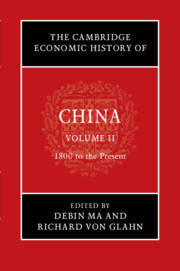Book contents
- The Cambridge Economic History of China
- The Cambridge Economic History of China
- The Cambridge Economic History of China
- Copyright page
- Contents
- Figures
- Maps
- Tables
- Contributors to Volume II
- Acknowledgments
- Note on Citations
- Introduction to Volume II
- Part I 1800–1950
- 1 Ideology and the Contours of Economic Change
- 2 Economic Transition in the Nineteenth Century
- 3 Agriculture
- 4 Handicraft and Modern Industries
- 5 The State and Enterprises in Late Qing China
- 6 State Enterprises during the First Half of the Twentieth Century
- 7 Money and the Macro-economy
- 8 Public Finance
- 9 Financial Institutions and Financial Markets
- 10 Chinese Business Organization
- 11 The Economic Impact of the West
- 12 Foreign Trade and Investment
- 13 Transport and Communication Infrastructure
- 14 Education and Human Capital
- Part II 1950 to the Present
- Index
- References
13 - Transport and Communication Infrastructure
from Part I - 1800–1950
Published online by Cambridge University Press: 07 February 2022
- The Cambridge Economic History of China
- The Cambridge Economic History of China
- The Cambridge Economic History of China
- Copyright page
- Contents
- Figures
- Maps
- Tables
- Contributors to Volume II
- Acknowledgments
- Note on Citations
- Introduction to Volume II
- Part I 1800–1950
- 1 Ideology and the Contours of Economic Change
- 2 Economic Transition in the Nineteenth Century
- 3 Agriculture
- 4 Handicraft and Modern Industries
- 5 The State and Enterprises in Late Qing China
- 6 State Enterprises during the First Half of the Twentieth Century
- 7 Money and the Macro-economy
- 8 Public Finance
- 9 Financial Institutions and Financial Markets
- 10 Chinese Business Organization
- 11 The Economic Impact of the West
- 12 Foreign Trade and Investment
- 13 Transport and Communication Infrastructure
- 14 Education and Human Capital
- Part II 1950 to the Present
- Index
- References
Summary
Modern means of transportation and communication along water, rails, and roads had a profound impact on the economic and social development of China from the mid-nineteenth century onward. After the arrival of the steamship in the 1840s and the telegraph in the early 1860s, railroad construction began to emerge slowly at the close of the century, followed by bus and motor traffic bringing about macadamized city streets and highway expansion, with a modest level of air traffic taking off in the 1930s. This chapter addresses the structural changes in transportation and communication that characterized the transition from the last decades of the Qing empire (1644–1911) through the Republican period (1911–1949) to the early years of the People’s Republic of China (PRC).
Keywords
- Type
- Chapter
- Information
- The Cambridge Economic History of China , pp. 457 - 495Publisher: Cambridge University PressPrint publication year: 2022



